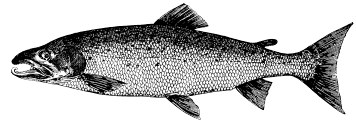 |
REGIONAL INFORMATION DIGESTECONOMY, ECOLOGY, HISTORY, CULTURE |
# 1, 1997
HUHO HUHO WON'T BE WORSE OFF...
V. SIDOROV, the Rybak Sakhalina Newspaper

..."It looks like a strongly pronounced predator, when gobbling it takes all that moves or glitters in front of its eyes. Its main objective is to grab and hold. What it needs it swallows, what it does not it lets go out the mouth." This is the way writers-naturalists depict the behavior of Huho Huho fish, still inhabiting the water bodies in the Sakhalin Administrative Region. But in Japan all traces of this endangered fish disappeared long since, except for about fifty "tails" meticulous researches have been able to count in the rivers of the Northern Hokkaido.
The Japanese relative has small or no difference from the Sakhalin Huho Huho, although named in Latin with a slight English accent, Huho Perry.
A sinful poacher from Sakhalin would not even guess right that we are talking about his most coveted trophy, the speckled salmon-trout, somewhere within the region of 20--30 kilograms! But pious Japanese fishermen will be happy to have a 1 kilo salmon-trout.
The Japanese grassroots exalt salmon-trout into a rank of a royal person. In the country of the rising sun, where people worship even breathless articles, like sakura or Fuji Volcano, the depleted salmon-trout stock has every chance to become a sacred fish, already referred to as a ghost. For an Eastern man to catch this fish and eat it is near the same as for a Christian to drink of the Cahors wine.
The Municipality of Adjigasawa, Japan, through the Sakhalin Brunch of Mitinoku Bank addressed the Sakhalin Administration with a proposal of cooperative salmon-trout artificial reproduction. The request for protegee in this unique endeavor followed in the right channel: from the Governor down through the Department of Fisheries and Kuril Islands toward Sakhalinrybvod Fish and Game Inspection.
The aquaculturists of Sakhalin, experienced in all sorts of salmon reproduction (Sockeye and Coho) even, did not know a thing about salmon-trout, while their colleagues in Aomori Prefecture in the North-West of the Honshu Island had already been involved in Huho Perry reproduction in the artificial environment for 22 years. They were ready to share the multi-year biotechnological knowledge with the Sakhalin Scientists.
This knowledge, bound into a 100 page illustrated manual, containing all sorts of tables and charts, can be found on the working table of Tatiana Lyubayeva, Deputy Chairwoman of Sakhalinrybvod. Tatiana. She cannot imagine that it might occur to someone to value this invaluable edition in Russian rubles or Japanese yens. They got clear on the "barter equivalent right away. The Japanese got half a liter of fertilized eggs of Sakhalin Huho Huho.
The simple cooperative action, as it seems from the outside, promises to develop into something bigger for both sides. As for us, it is clear enough: the future generations will remember with gratitude these current efforts of reproducing salmon-trout drawing on our neighbors" experience. As far as Japanese are concerned, their further accumulation of knowledge on Huho Perry salmon-trout would stuck if not for our Huho Huho. The Japanese parent stock was built in artificial conditions during a 25 year period, all from the thousand eggs taken from one ancestor, caught in the North Hokkaido. Already the third generation of Huho Perry was nearly struck by the royal disease, because of the incest. The fresh blood, as they say, was required to renew the genetic stock.
The joint Russian-Japanese salmon-trout fishing operation was successfully conducted in spring, when the fish returned for the Spawning Run 1996 into the Tunaichi river. Having shared the eggs of a landed female salmon-trout, the aquaculturists went every which way to lay the eggs for hatching. 3000 fertilized eggs flew in a special container to Japan. About the same quantity was laid at the Lesnoi Fish Farm in Sakhalin.
By the end of June, in Japan the "migrants" from Sakhalin hatched. The Japanese were first baffled by the low survival of live fry, just 800, then it was blamed on the transportation problems. Then they were immensely pleased with the nutritional state of the "Hercules" born by Mother Nature.
Simultaneously, the first ever salmon-trout progeny hatched in artificial conditions in Sakhalin. In the fall of the same year, about two thousand juveniles raised at the Lesnoi Fish Farm were released into Podorozhka and Ochepukha rivers. The remainder of 400 juveniles were kept for further research and raising in the plastic pools of the Okhotskiy Fish Farm.
The Municipality of Adjigasawa openly expressed their satisfaction with the cooperative action and invited a group of Sakhalinrybvod and SakhNIRO to see with their own eyes the results of the experiment. The Municipality of the 15 thousand population town attached to the visit of Sakhalin experts such an importance that their popularity spread far beyond the limits of the prefecture. 11 years ago, before the first salmon trout farm was built in Adjigasawa, the initiative of artificial reproduction of Huho Perry belonged to the Fishing Faculty of the Hokkaido University. Under current observation of professors and students are about eighty salmon-trout adults. But the specialized farm takes care of several hundreds. Frolicking here are also the "god-children" of Sakhalin and Japanese aquaculturists. By the way, how they are going to name their future off-spring? Huho Huho or Huho Perry? Anyway, for the experts of the neighboring countries it is more important that opened was a new page in the history of aquaculture, where the closing chapter is far out of sight as yet, which is proved by the Protocol of Intent signed for further cooperation in 1997.